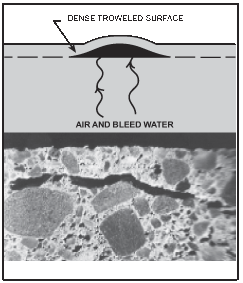Information from the National Ready Mixed Concrete Association
What Are Blisters?

Concrete Bister
Blisters are hollow, low-profile bumps on the concrete surface, typically from the size of a dime up to 1 inch (25 mm), but occasionally even 2 or 3 inches (50 – 75 mm) in diameter. A dense troweled skin of mortar about 1/8 in. (3 mm) thick covers an underlying void that moves around under the surface during troweling. Blisters may occur shortly after the completion of finishing operation. In poorly lighted areas, small blisters may be difficult to see during finishing and may not be detected until they break under traffic.
WHY Do Blisters Form?
Blisters may form on the surface of fresh concrete when either bubbles of entrapped air or bleed water migrate through the concrete and become trapped under the surface, which has been sealed prematurely during the finishing operations. These defects are not easily repaired after concrete hardens.
Blisters are more likely to form if:
- Insufficient or excessive vibration is employed. Insufficient vibration prevents the entrapped air from being released and excessive use of vibrating screeds works up a thick mortar layer on the surface.
- An improper tool is used for floating the surface or it is used improperly. The surface should be tested to determine which tool, whether it be wood or magnesium bull float, does not seal the surface. The floating tool should be kept as flat as possible.
- Excessive evaporation of bleed water occurs and the concrete appears ready for final finishing operations (premature finishing), when, in fact, the underlying concrete is still releasing bleed water and entrapped air. High rate of bleed water evaporation is especially a problem during periods of high ambient temperatures, high winds and/or low humidity.
- Entrained air is used or is higher than normal. Rate of bleeding and quantity of bleed water is greatly reduced in air-entrained concrete giving the appearance that the concrete is ready to float and further finish causing premature finishing.
- The subgrade is cooler than concrete. The top surface sets faster than the concrete in the bottom and the surface appears ready to be floated and further finished.
- The slab is thick and it takes a longer time for the entrapped air and bleed water to rise to the surface.
- The concrete is cohesive or sticky from higher content of cementitious materials or excessive fines in the sand. These mixtures also bleed less and at a slower rate. Concrete mixtures with lower contents of cementitious materials bleed rapidly for a shorter period, have higher total bleeding and tend to delay finishing.
- A dry shake is prematurely applied, particularly over air-entrained concrete.
The slab is placed directly on top of a vapor retarder or an impervious base, preventing bleed water from being absorbed by the subgrade.
HOW to Prevent Blisters
The finisher should be wary of a concrete surface that appears to be ready for final finishing before it would normally be expected. Emphasis in finishing operations should be on placing, striking off and bull floating the concrete as rapidly as possible and without working up a layer of mortar on the surface. After these operations are completed, further finishing should be delayed as long as possible and the surface covered with polyethylene or otherwise protected from evaporation. If conditions for high evaporation rates exist, place a cover on a small portion of the slab to judge if the concrete is still bleeding. In initial floating, the float blades should be flat to avoid densifying the surface too early. Use of an accelerating admixture or heated concrete often prevents blisters in cool weather. It is recommended that non-air entrained concrete be used in interior slabs and that air entrained concrete not be steel troweled.
If blisters are forming, try to either flatten the trowel blades or tear the surface with a wood float and delay finishing as long as possible. Under conditions causing rapid evaporation, slow evaporation by using wind breaks, water misting of the surface, evaporation retarders, or a cover (polyethylene film or wet burlap) between finishing operations. Further recommendations are given in ACI 302.1R and ACI 305.
Follow These Rules to Avoid Blisters
- Do not seal surface before air or bleed water from below have had a chance to escape.
- Avoid dry shakes on air-entrained concrete.
- Use heated or accelerated concrete to promote even setting throughout the depth of the slab in cooler weather.
- Do not place slabs directly on vapor retarders. If vapor retarders are essential (CIP 28) take steps to avoid premature finishing.
- Protect surface from premature drying and evaporation.
- Do not use a jitterbug or excessive vibration such as a vibratory screed on slumps over 5 inches (125 mm).
- Air entrained concrete should not be steel troweled. If required by specifications, extreme caution should be exercised when timing the finishing operation.
References
- Guide for Concrete Floor and Slab Construction, ACI 302.1R, American Concrete Institute, Farmington Hills, MI. www.concrete.org
- Slabs on Grade, ACI Concrete Craftsman Series, CCS 1, American Concrete Institute, Farmington Hills, MI.
- Hot weather Concreting, ACI 305R, American Concrete Institute, Farmington Hills, MI.
- Concrete Slab Surface Defects: Causes, Prevention,Repair, IS 177, Portland Cement Association, Skokie, IL. www.cement.org
- Concrete Surface Blistering—Causes and Cures, Carl O. Peterson, Concrete Construction, September 1970. www.concreteconstruction.net
- CIP 14 – Finishing Concrete Flatwork; CIP 20 – Delamination of Troweled Concrete Surfaces, NRMCA CIP Series. www.nrmca.org.
- Finishing, Concrete Construction, August 1976, p.
- Finishing Problems and Surface Defects in Flatwork, Concrete Construction, April 1979.
USED WITH PERMISSION FROM THE NRMCA
